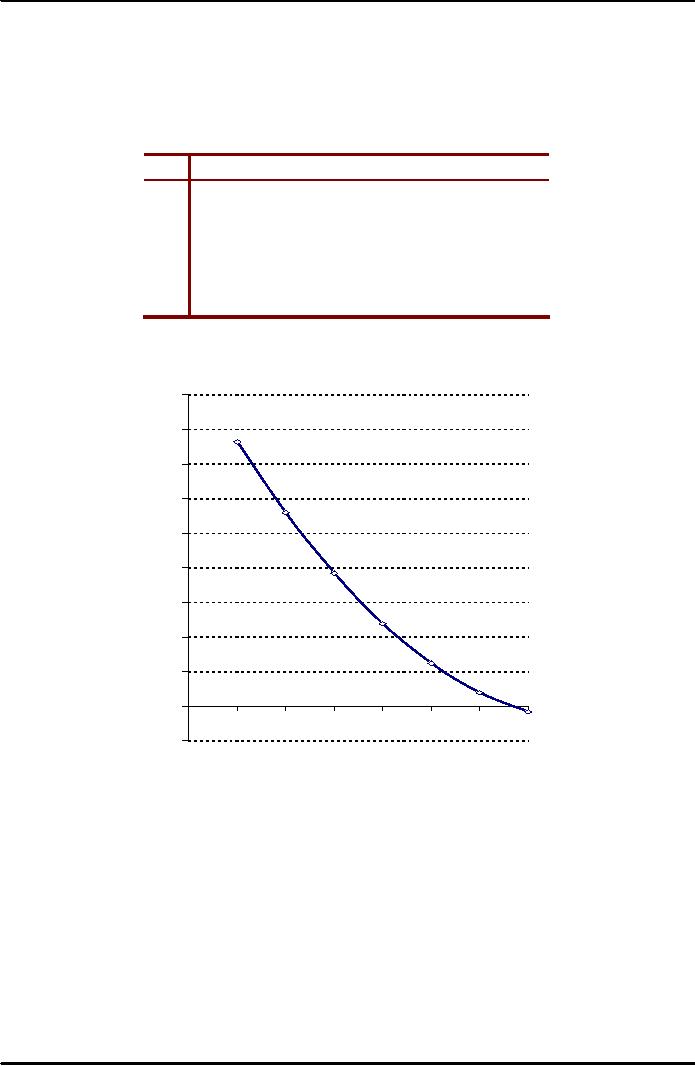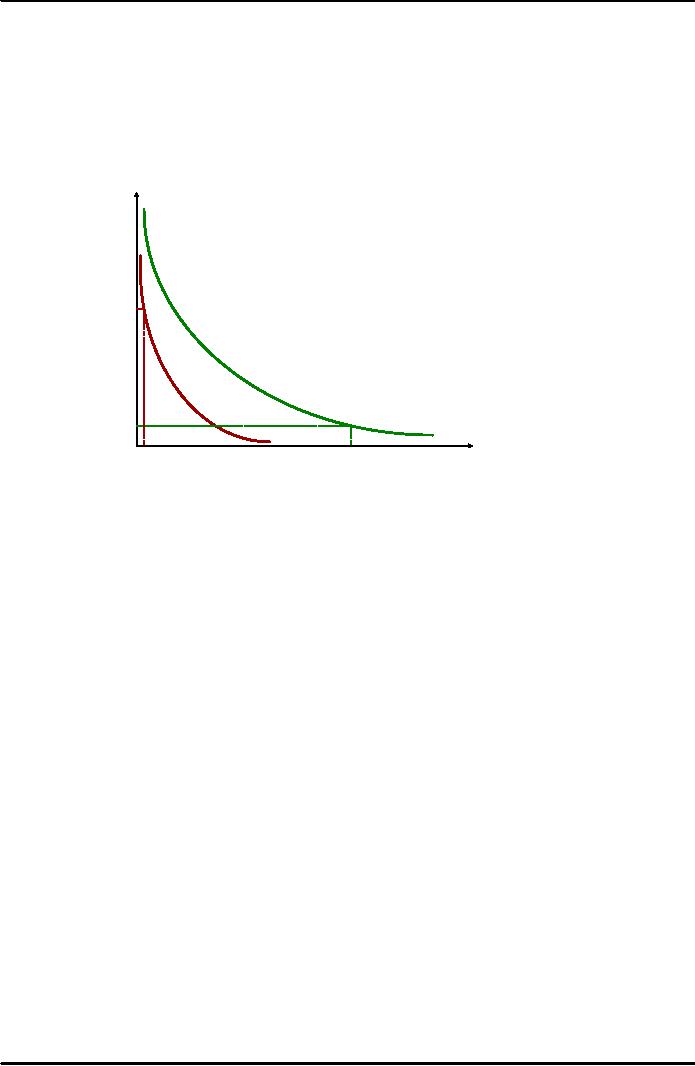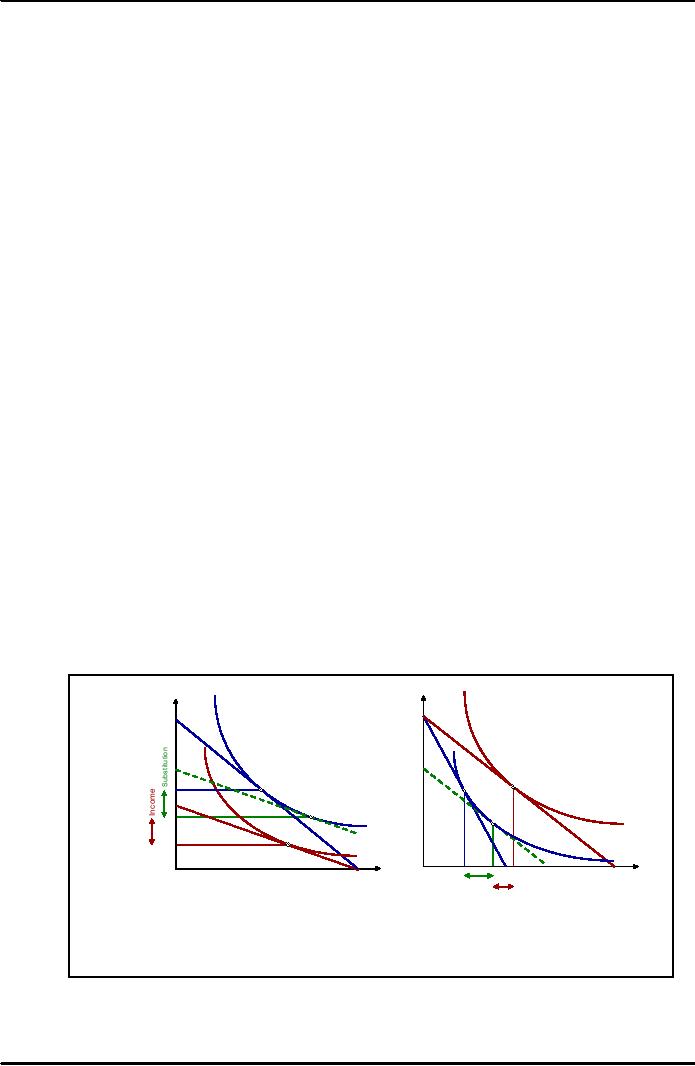 |

Introduction
to Economics ECO401
VU
Lesson
4.4
BACKGROUND
TO DEMAND/CONSUMPTION
(CONTINUED................)
Normal
Goods and Giffen
Good:
A
normal good is one whose
consumption increases when
income increases, while
inferior
good
is one whose consumption
decreases with increase in
income.
A
Giffen good is a sub-category of
inferior goods; its
consumption increases when
it's price
increases.
This is because of its very
strong income effect.
Both
normal and inferior goods
have downward sloping demand
curves.
The
Income Consumption Curve
(ICC) and Price Consumption
Curve (PPC):
The
income consumption curve
(ICC) can be used to derive
the Engel Curve, which
shows the
relationship
between income and quantity
demanded.
The
price consumption curve
(PCC) traces out the
optimal choice of consumption at
different
prices.
The PCC can be used to
derive the demand curve,
which shows the
relationship
between
price & quantity
demanded.
When
the price of one good
change, two things
happen:
�
One
the purchasing power of
consumer changes i.e., the
budget line shifts (leads
to
income
effect).
�
Secondly,
the slope of budget line
changes due to a change in
the relative price
ratio
(leads
to substitution effect).
The
substitution effect of a price
rise is always negative,
while the income
effect of a
price
rise
on the consumption of a normal
good is negative. The
income effect for an
inferior good
is
positive. The income effect
of a Giffen good is so positive
that it offsets the
negative
substitution
effect, therefore.
Limitation
of Indifference Approach:
The
indifference curves approach
has the following
limitations:
a.
Indifference curve analysis is
only possible for 2 or at
best for 3 goods.
b.
It is almost impossible to practically
derive indifference
curves.
c.
The consumer may not
always behave
rationally.
d.
The consumer may not
always realize the level of
utility (ex-post) from
consumption,
that
she originally expected
(ex-ante).
e.
Indifference curve analysis
can not help when
one of the goods (X or Y) is a
durable
good.
32

Introduction
to Economics ECO401
VU
END
OF UNIT 4 - EXERCISES
Do
you ever purchase things
irrationally? If so, what
are they and why is
your
behaviour
irrational?
A
good example is things you
purchase impulsively, when in
fact you do have time to
reflect
on
whether you really want
them. It is not a question of
ignorance but a lack of
care. Your
behaviour
is irrational because the
marginal benefit of a bit of
extra care would exceed
the
marginal
effort involved.
Imagine
that you are going
out for the evening
with a group of friends. How
would you
decide
where to go? Would this
decision-making process be described as
`rational'
behaviour?
You
would probably discuss it
and try to reach a consensus
view. The benefits to you
(and to
other
group members) would
probably be maximized in this
way. Whether these
benefits
would
be seen as purely `selfish' on
the part of the members of
the group, or whether
people
have
more genuinely unselfish
approach, will depend on the
individuals involved.
If
you buy something in the
shop on the corner when
you know that the
same item
could
have been bought more
cheaply two miles up the
road from the
wholesale
market,
is your behaviour irrational?
Explain.
Not
necessarily. If you could
not have anticipated wanting
the item and if it would
cost you
time
and effort and maybe
money (e.g. petrol) to go to
the wholesale market, then
your
behaviour
is rational. Your behaviour a
few days previously would
have be irrational,
however,
if,
when making out your
weekly shopping list for
the wholesale market, a
moment's thought
could
have saved you having to
make the subsequent trip to
the shop on the
corner.
Are
there any goods or services
where consumers do not
experience diminishing
marginal
utility?
Virtually
none, if the time period is
short enough. If, however,
we are referring to a long
time
period,
such as a year, then
initially as more of an item is
consumed people may start
`getting
more
of a taste for it' and
thus experience increasing
marginal utility. But even
with such
items,
eventually, as consumption increases,
diminishing marginal utility
will be experienced.
If
Ammaar were to consume more
and more crisps, would
his total utility ever
(a) fall to
zero;
(b) become negative?
Explain.
Yes,
both. If he went on eating
more and more, eventually he
would feel more
dissatisfied
than
if he had never eaten any in
the first place. He might
actually be physically
sick!
Complete
this table to the level of
consumption at which total
utility (TU) is at a
maximum,
given
the utility function TU = Q +
60Q 4Q2.
4Q2
Q
60Q
=
TU
1
60
4
=
56
2
120
16
=
104
3
180
36
=
144
4
240
64
=
176
5
300
100
=
200
6
360
144
=
216
7
420
196
=
224
8
480
256
=
224
Derive
the MU function from the
following TU function:
33

Introduction
to Economics ECO401
VU
TU
= 200Q 25Q� + Q�
From
this MU function, draw up a
table (like the one
above) up to the level of Q
where MU
becomes
negative. Graph these
figures.
MU
= dTU/dQ = 200 50Q +
3Q�
3Q2
Q
MU
200
50Q
+
=
1
200
50
+
3
=
153
2
200
100
+
12
=
112
3
200
150
+
27
=
77
4
200
200
+
48
=
48
5
200
250
+
75
=
25
6
200
300
+
108
=
8
7
200
350
+
147
=
3
180
160
140
120
100
80
60
40
20
MU
0
0
1
2
3
4
5
6
7
-2
0
If
a good were free, why would
total consumer surplus equal
total utility? What would
be
the
level of marginal
utility?
Because
there would be no expenditure. At
the point of maximum
consumer surplus,
marginal
utility
would be equal to zero,
since if P = 0, and MU = P, then MU =
0.
Why
do we get less consumer
surplus from goods where
our demand is
relatively
elastic?
Because
we would not be prepared to
pay such a high price
for them. If price went
up, we
would
more readily switch to
alternative products.
How
would marginal utility and
market demand be affected by a
rise in the price of
a
complementary
good?
Marginal
utility and market demand
would fall (shift to the
left). The rise in the
price of the
complement
would cause less of it to be
consumed. This would
therefore reduce the
marginal
34

Introduction
to Economics ECO401
VU
utility
of the other good. For
example, if the price of
lettuce goes up and as a
result we consume
less
lettuce, the marginal
utility of mayonnaise will
fall.
The
diagram illustrates a person's MU
curves of water and
diamonds. Assume
that
diamonds
are more expensive than
water. Show how the MU of
diamonds will be
greater
than
the MU of water. Show also
how the TU of diamonds will
be less than the TU
of
water.
MU,
P
Pd
Pw
MU
water
MU
diamonds
Qd
Qw
Define
`risk' and
`uncertainty'.
Risk:
when an outcome may or may
not occur, but its
probability of occurring is
known.
Uncertainty:
when an outcome may or may
not occur and its
probability of occurring is
not
known.
Give
some examples of gambling
(or risk taking in general)
where the odds are
(a)
unfavorable;
(b) fair; (c)
favourable.
a.
Betting on the horses; firms
launching a new product in a
market that is already
virtually
saturated
and where the firm
does not bother to
advertise.
b.
Gambling on a private game of
cards which is a game of
pure chance; deciding which
of
two
alternative brands to buy
when they both cost
the same and you
have no idea which
you
will like the
best.
c.
The buying and selling of
shares on the stock exchange
by dealers who are skilled
in
predicting
share price movements; not
taking an umbrella when the
forecast is that it
will
not
rain (weather forecasts are
right more often than
they are wrong!); an
employer
taking
on a new manager who has
excellent references from
previous employers.
(Note
that in the cases of (a)
and (c) the actual
odds may not be known,
only that they
are
unfavorable
or favourable.)
Which
game would you be more
willing to play, a 60:40
chance of gaining or losing
Rs10
000,
or a 40:60 chance of gaining or
losing Re1? Explain
why.
Most
people would probably prefer
the 40:60 chance of gaining
or losing Re1. The reason
is
that,
given the diminishing
marginal utility of income,
the benefit of gaining Rs10
000 may be
considerably
less than the costs of
losing Rs10 000, and
this may be more than
enough to deter
people,
despite the fact that
the chances of winning are
60:40.
Do
you think that this
provides a moral argument
for redistributing income
from the rich
to
the poor? Does it prove
that income should be so
redistributed?
35

Introduction
to Economics ECO401
VU
Arguments
like this are frequently
used to justify redistributing
income and form part of
people's
moral
code. Most people would
argue that the rich
ought to pay more in taxes
than the poor
and
that
the poor ought to receive
more state benefits than
the rich. The argument is
frequently
expressed
in terms of a pound being
worth more to a poor person
than a rich person. It
does
not
prove that income should be
so redistributed, however, unless
you argue (a) that
the
government
ought to increase total
utility in society and (b)
that it is possible to compare
the
utility
gained by poor people with
that lost by rich people
something that is virtually
impossible
to
do.
What
details does an insurance
company require to know
before it will insure a
person to
drive
a car?
Age;
sex; occupation; accident
record; number of years that
a license has been held;
traffic law
violations
and convictions; model and
value of the car; age of
the car; details of other
drivers of
the
car.
How
will the following reduce
moral hazard?
a.
A no-claims bonus.
b.
The driver having to pay
the first so many rupees of
any claim (called
"excess").
c.
Offering lower premiums to
those less likely to claim
(e.g. if a house has a
burglar alarm,
it
is less likely to be burgled
and therefore the insurance
premiums for its contents
TV,
VCR,
etc. can be reduced by the
insurance company).
In
the case of (a) and
(b) people will be more
careful as they would incur
a financial loss if
the
event
they were insured against
occurred (loss of no-claims
bonus; paying the first so
much of
the
claim). In the case of (c)
it distinguishes people more
accurately according to risk.
It
encourages
people to move into the
category of those less
likely to claim (but it does
not make
people
more careful within a
category: e.g. those with
burglar alarms may be less
inclined to turn
them
on if they are well
insured!).
If
people are generally risk
averse, why do so many people around
the world take part
in
national
lotteries?
Because
the cost of taking part is
so little, that they do not
regard it as a sacrifice. They
also are
likely
to take a `hopeful' view
(i.e. not based on the
true odds) on their chances
of winning. What
is
more, the act of taking
part itself gives pleasure.
Thus the behaviour can
still be classed as
`rational':
i.e. one where the
perceived marginal benefit of
the gamble exceeds the
marginal cost.
Why
are insurance companies
unwilling to provide insurance
against losses arising
from
war
or `civil disorder'?
Because
the risks are not
independent. If family A has
its house bombed, it is more
likely that
family
B will too.
Name
some other events where it
would be impossible to obtain
insurance.
Against
losses on the stock market;
against crop losses
resulting from
drought.
Although
indifference curves will
normally be bowed in toward
the origin, on
odd
occasions
they might not be.
What would indifference
curves look like in each of
the
following
cases?
a.
X and Y are left shoes
and right shoes.
b.
X and Y are two brands of
the same product, and
the consumer cannot tell
them
apart.
c.
X is a good but Y is a `bad'
like household
refuse.
a.
L-shaped. An additional left
shoe will give no extra
utility without an additional
right shoe
to
go with it!
b.
Straight lines. The consumer
is prepared to go on giving up one
unit of one brand
provided
that it is replaced by one
unit of the other
brand.
36

Introduction
to Economics ECO401
VU
c.
Upward sloping. If consumers
are to be persuaded to put up
with more of the `bad',
they
must
have more of the good to
compensate.
What
will happen to the budget
line if the consumer's
income doubles and the
price of
both
X and Y double?
It
will not move. Exactly
the same quantities can be
purchased as before. Money
income has
risen,
but real income has
remained the same.
The
incomeconsumption curve is often
drawn as positively sloped at
low levels of
income.
Why?
Because
for those on a low level of
income the good is not
yet in the category of an
inferior
good.
Take the case of inexpensive
margarine. Those on very low
incomes may economise
on
their
use of it (along with all
other products), but as they
earn a little more, so they
can afford to
spread
it a little thicker or use it
more frequently (the
incomeconsumption curve is
positive).
Only
when their income rises
more substantially do they
substitute better quality
margarines or
butter.
Illustrate
on an indifference diagram the
effects of the following: A
ceteris paribus (a)
rise
in
the price of good Y (b)
fall in the price of good
X.
a.
The budget line will
pivot inwards from B1 to
B2.
b.
The budget line would
pivot outward on the point
where the budget line
crosses the
vertical
axis. It is likely that the
new tangency point with an
indifference curve
will
represent
an increase in the consumption of
both goods. The diagram
above can be
used
to illustrate this. Assume
the budget line pivots
outwards from B1 to B2.
The
optimum
consumption point will move
from point a to c.
Illustrate
the income and substitution
effects in the above
question.
See
the diagram above. In each
case the substitution effect
is shown by a movement from
point
a
to point b and the
substitution effect is shown by a
movement from point b to
point c.
Are
there any Giffen goods
that you consume? If
not, could you conceive of
any
circumstances
in which one or more items
of your expenditure would
become Giffen
goods?
Good
Y
Good
Y
B1
B1a
c
a
a
B2
b
b
I2
I1
c
B2
I2
B1
B1a
I1
Good
X
Substitution
Good
X
Income
(b)
Decrease
in price of X
(a)
Increase
in price of Y
37

Introduction
to Economics ECO401
VU
It
is unlikely that any of the
goods you consume are
Giffen goods. One
possible
exception
may be goods where you
have a specific budget for
two or more items,
where
one item is much cheaper:
e.g. fruit bought from a
greengrocer (or rehri
waala
on
the street). If, say,
apples are initially much
cheaper than bananas, you
may be able
to
afford some of each. Then
you find that apples
have gone up in price, but
are still
cheaper
than bananas. What do you
do? By continuing to buy
some of each fruit
you
may
feel that you are
not eating enough pieces of
fruit to keep you healthy
and so you
substitute
apples for bananas, thereby
purchasing more apples than
before (but
probably
less pieces of fruit than
originally).
38
Table of Contents:
- INTRODUCTION TO ECONOMICS:Economic Systems
- INTRODUCTION TO ECONOMICS (CONTINUED………):Opportunity Cost
- DEMAND, SUPPLY AND EQUILIBRIUM:Goods Market and Factors Market
- DEMAND, SUPPLY AND EQUILIBRIUM (CONTINUED……..)
- DEMAND, SUPPLY AND EQUILIBRIUM (CONTINUED……..):Equilibrium
- ELASTICITIES:Price Elasticity of Demand, Point Elasticity, Arc Elasticity
- ELASTICITIES (CONTINUED………….):Total revenue and Elasticity
- ELASTICITIES (CONTINUED………….):Short Run and Long Run, Incidence of Taxation
- BACKGROUND TO DEMAND/CONSUMPTION:CONSUMER BEHAVIOR
- BACKGROUND TO DEMAND/CONSUMPTION (CONTINUED…………….)
- BACKGROUND TO DEMAND/CONSUMPTION (CONTINUED…………….)The Indifference Curve Approach
- BACKGROUND TO DEMAND/CONSUMPTION (CONTINUED…………….):Normal Goods and Giffen Good
- BACKGROUND TO SUPPLY/COSTS:PRODUCTIVE THEORY
- BACKGROUND TO SUPPLY/COSTS (CONTINUED…………..):The Scale of Production
- BACKGROUND TO SUPPLY/COSTS (CONTINUED…………..):Isoquant
- BACKGROUND TO SUPPLY/COSTS (CONTINUED…………..):COSTS
- BACKGROUND TO SUPPLY/COSTS (CONTINUED…………..):REVENUES
- BACKGROUND TO SUPPLY/COSTS (CONTINUED…………..):PROFIT MAXIMISATION
- MARKET STRUCTURES:PERFECT COMPETITION, Allocative efficiency
- MARKET STRUCTURES (CONTINUED………..):MONOPOLY
- MARKET STRUCTURES (CONTINUED………..):PRICE DISCRIMINATION
- MARKET STRUCTURES (CONTINUED………..):OLIGOPOLY
- SELECTED ISSUES IN MICROECONOMICS:WELFARE ECONOMICS
- SELECTED ISSUES IN MICROECONOMICS (CONTINUED……………)
- INTRODUCTION TO MACROECONOMICS:Price Level and its Effects:
- INTRODUCTION TO MACROECONOMICS (CONTINUED………..)
- INTRODUCTION TO MACROECONOMICS (CONTINUED………..):The Monetarist School
- THE USE OF MACROECONOMIC DATA, AND THE DEFINITION AND ACCOUNTING OF NATIONAL INCOME
- THE USE OF MACROECONOMIC DATA, AND THE DEFINITION AND ACCOUNTING OF NATIONAL INCOME (CONTINUED……………..)
- MACROECONOMIC EQUILIBRIUM & VARIABLES; THE DETERMINATION OF EQUILIBRIUM INCOME
- MACROECONOMIC EQUILIBRIUM & VARIABLES; THE DETERMINATION OF EQUILIBRIUM INCOME (CONTINUED………..)
- MACROECONOMIC EQUILIBRIUM & VARIABLES; THE DETERMINATION OF EQUILIBRIUM INCOME (CONTINUED………..):The Accelerator
- THE FOUR BIG MACROECONOMIC ISSUES AND THEIR INTER-RELATIONSHIPS
- THE FOUR BIG MACROECONOMIC ISSUES AND THEIR INTER-RELATIONSHIPS (CONTINUED…….)
- THE FOUR BIG MACROECONOMIC ISSUES AND THEIR INTER-RELATIONSHIPS (CONTINUED…….):Causes of Inflation
- THE FOUR BIG MACROECONOMIC ISSUES AND THEIR INTER-RELATIONSHIPS (CONTINUED…….):BALANCE OF PAYMENTS
- THE FOUR BIG MACROECONOMIC ISSUES AND THEIR INTER-RELATIONSHIPS (CONTINUED…….):GROWTH
- THE FOUR BIG MACROECONOMIC ISSUES AND THEIR INTER-RELATIONSHIPS (CONTINUED…….):Land
- THE FOUR BIG MACROECONOMIC ISSUES AND THEIR INTER-RELATIONSHIPS (CONTINUED…….):Growth-inflation
- FISCAL POLICY AND TAXATION:Budget Deficit, Budget Surplus and Balanced Budget
- MONEY, CENTRAL BANKING AND MONETARY POLICY
- MONEY, CENTRAL BANKING AND MONETARY POLICY (CONTINUED…….)
- JOINT EQUILIBRIUM IN THE MONEY AND GOODS MARKETS: THE IS-LM FRAMEWORK
- AN INTRODUCTION TO INTERNATIONAL TRADE AND FINANCE
- PROBLEMS OF LOWER INCOME COUNTRIES:Poverty trap theories: